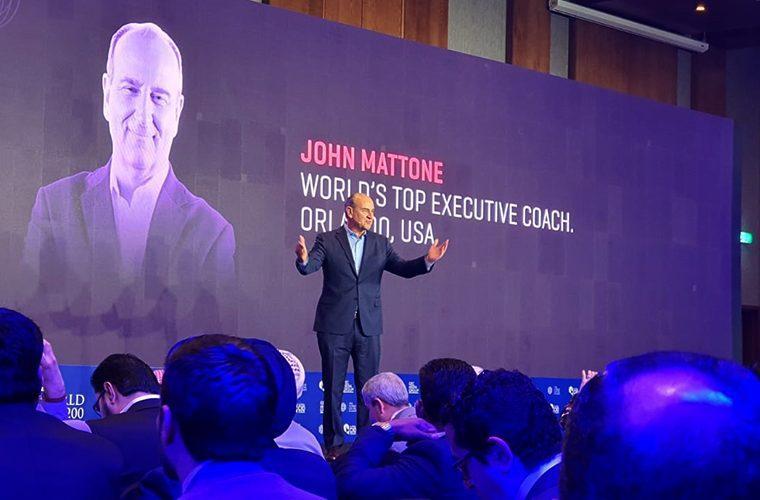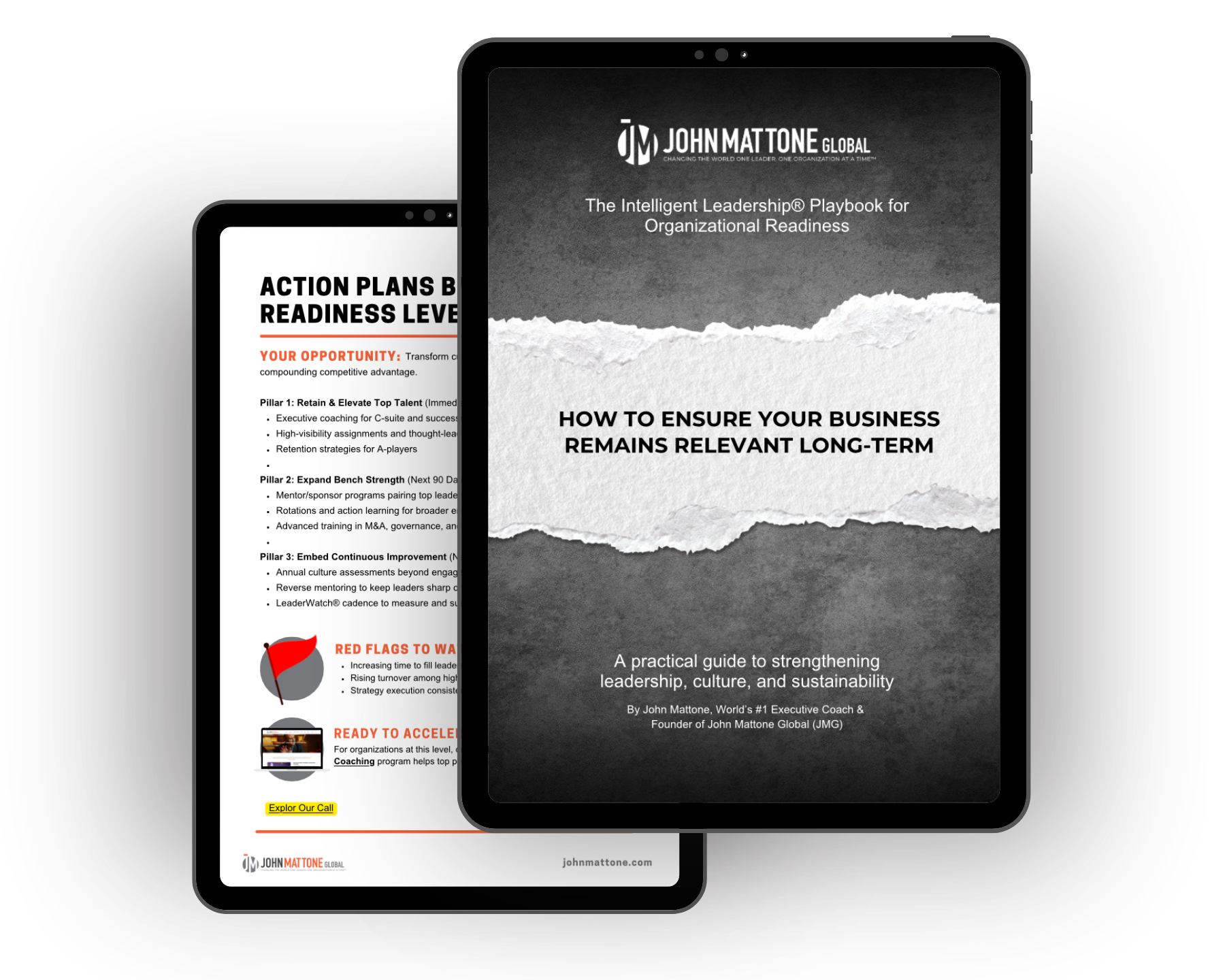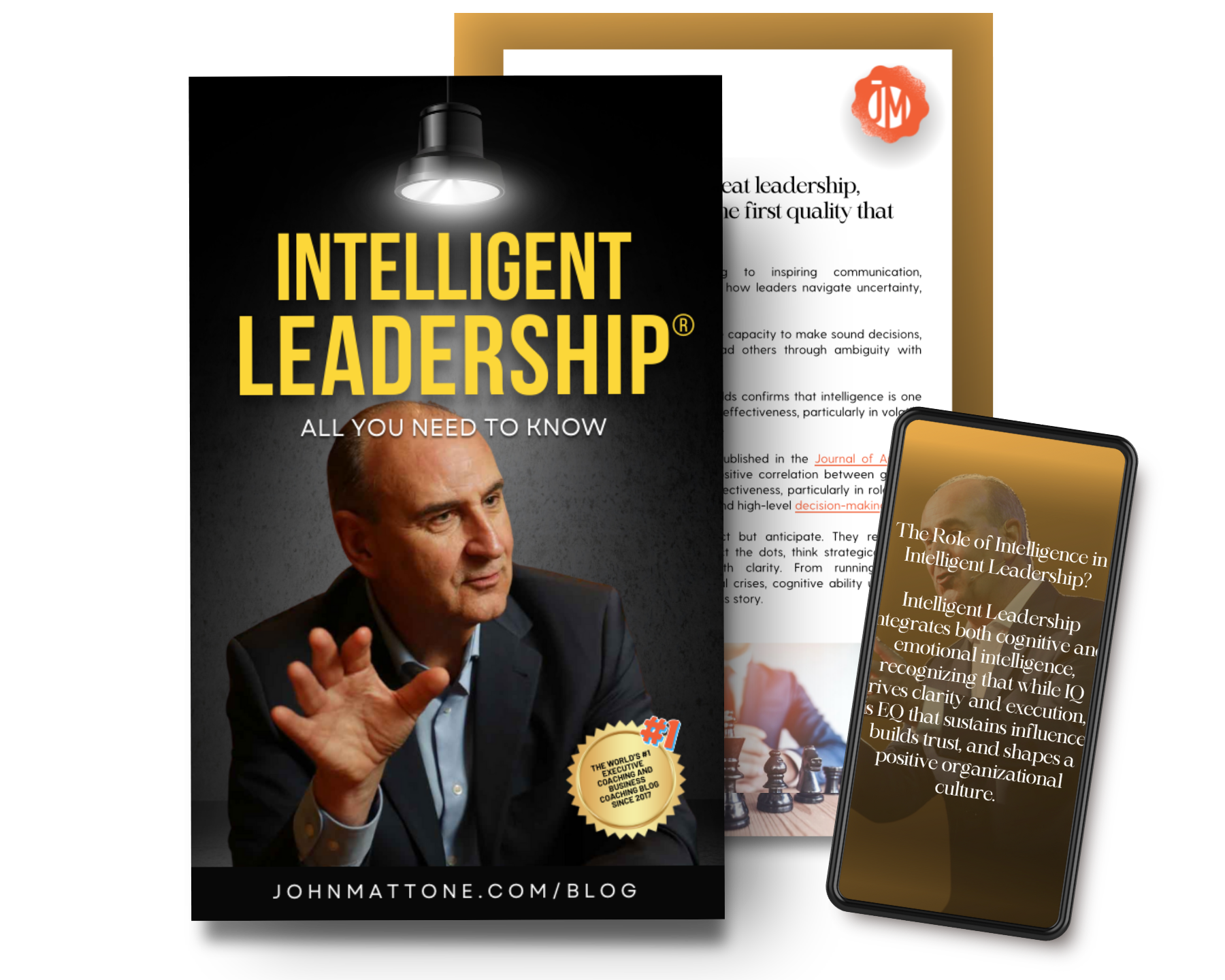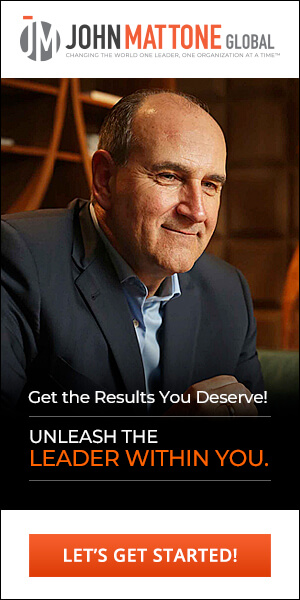A good leader unites inner strength with outer competence. According to my Intelligent Leadership framework, great leaders develop character, self-awareness, emotional maturity, capability, commitment, alignment, and relationships: creating trust, purpose, and lasting impact that elevates both people and performance.
What makes a good leader in the complicated times we live in? The answer lies beyond skill or title. It begins within. In my work with leaders across industries and cultures, I’ve learned that truly effective leadership starts with character.
When the inner core (values, beliefs, and emotional maturity) aligns with the outer core (behaviors, relationships, and results), transformation occurs. This alignment is the foundation of Intelligent Leadership.
Leadership is not about power or position; it is about purpose, self-awareness, and impact. In the following sections, I’ll reveal the seven inner and outer qualities that define Intelligent Leadership and elevate good leaders into great ones.
Defining Good Leadership

Good leadership is not about authority or position, it’s about who you are at your core. True leadership blends inner strength with outer effectiveness, creating alignment between purpose, values, and results.
The skills that make a good leader are not only the ability to direct others but the courage to look inward. Leadership begins with who you are before it’s expressed through what you do.
In my coaching work, I’ve seen that good leadership thrives where character meets competence. It’s the fusion of inner clarity and outward execution.
According to the American Psychological Association, the most effective leaders demonstrate emotional intelligence, adaptability, and moral conviction. These qualities enable them to unite diverse teams, guide through uncertainty, and align purpose with organizational goals.
Truly great managers are not always natural-born leaders. They are built from the inside out.
The Inner vs Outer Core: Building the Bridge
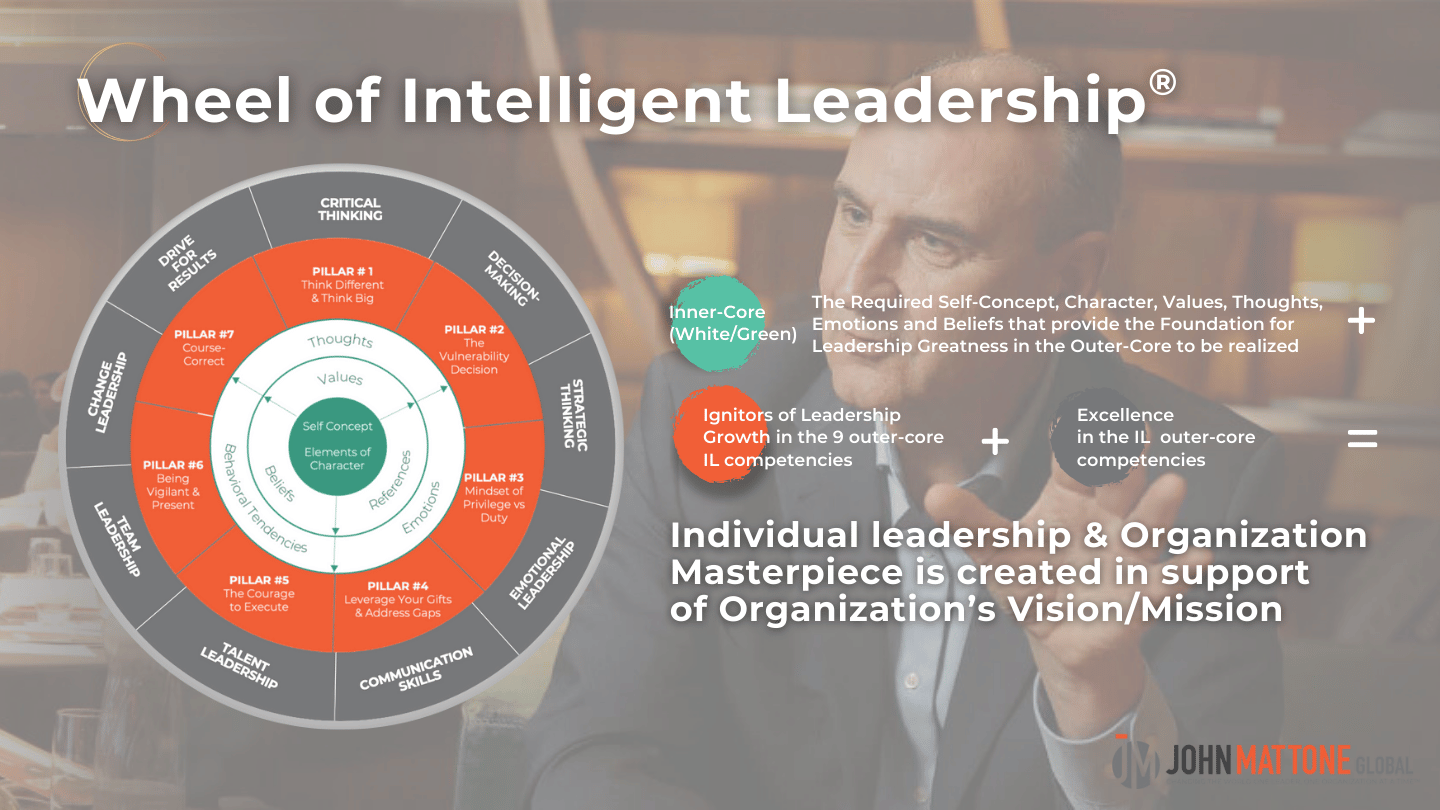
Every great leader masters two worlds: the inner and the outer. Intelligent Leadership begins when character and competence unite, transforming personal growth into lasting impact.
The Inner Core: Who You Are Defines How You Lead
The inner core represents your deepest self: your values, beliefs, character, and emotional maturity. It’s the foundation of your leadership journey. I’ve found that leaders who develop self-awareness and a strong moral compass are far more likely to build trust and sustain influence.
Research from the Harvard Business Review shows that emotional intelligence (self-awareness, self-regulation, empathy, and motivation) is what truly distinguishes great leaders from good ones.
Cultivating these inner traits builds resilience and clarity, especially during times of uncertainty.
The Outer Core: What Great Leaders Do
Your outer core is what others see: your communication, decision-making, and ability to connect with people. It’s the expression of your inner world in motion. When your actions reflect your values, you inspire authenticity and trust.
Great leaders communicate with empathy, set clear expectations, and empower their team members to perform at their best. When inner conviction and outer behavior align, leadership stops being performative. It becomes transformative.
How Do Leaders Build the Bridge Between the Inner and Outer Core?

Leaders build this bridge by aligning their inner character with their outer actions. When integrity, emotional maturity, and courage guide communication and decision-making, leadership becomes authentic and deeply influential.
The Power of Alignment
True leadership emerges when your inner and outer cores are in harmony. It’s the point where personal integrity fuels professional excellence.
Leaders who cross this bridge consistently act with clarity, compassion, and conviction. Their decisions reflect not ego, but purpose. This alignment transforms leadership from task management into people elevation.
The Bridge Between Inner and Outer Core
| Inner Core (Who You Are) | Outer Core (What You Do) | Leadership Outcome |
| Self-awareness | Clear communication | Builds trust and alignment |
| Character and values | Ethical decision-making | Strengthens credibility and influence |
| Emotional maturity | Composure under pressure | Inspires confidence and stability |
| Growth mindset | Continuous learning | Drives innovation and adaptability |
| Courage and humility | Empowering team members | Fosters collaboration and respect |
When both cores are strengthened, leaders stop reacting to circumstances and start creating them.
How Does Transformation Happen?
In my coaching work, I’ve seen many leaders move from transactional leadership, focused on compliance and control, to transformational leadership, driven by purpose and connection.
The American Psychological Association notes that transformational leaders achieve higher engagement because they connect with both the hearts and minds of their teams.
The Bridge in Action
Consider leaders like Nelson Mandela or Satya Nadella. Both exemplify alignment between the inner and outer cores. Their humility, vision, and authenticity inspired not only performance but transformation.
This is what happens when leaders build their bridge: they lead from their best self and invite others to do the same.
What Are the 7 Essential Dimensions of Intelligent Leadership?

The seven essential dimensions of Intelligent Leadership are thinking differently and thinking big, the vulnerability decision, mindset of duty, leveraging your gifts and addressing your gaps, courage to execute, staying present and vigilant, and course correction. Together, they form the pathway to authentic, world-class leadership.
To achieve this harmony, every leader must cultivate seven essential dimensions (or leadership qualities) that shape their thinking, decision-making, and leadership. These dimensions represent the pathway to greatness, bridging who you are with how you lead.
The 7 Dimensions of Intelligent Leadership
1. Thinking Differently, Thinking Big
Leadership begins with how you think. Intelligent leaders stretch beyond conventional limits; they cultivate the courage to dream big and challenge assumptions. Thinking big isn’t about arrogance. It’s about possibility. When leaders expand their perspective, they expand their impact.
“If your vision doesn’t scare you just a little, it’s probably not big enough.”
2. The Vulnerability Decision
Vulnerability is not weakness; it’s the birthplace of authenticity. I’ve found that the strongest leaders are those who choose transparency, who admit mistakes, ask for help, and invite feedback. This decision to be vulnerable builds trust and accelerates personal growth, because no transformation begins without honesty.
3. Mindset of Duty (vs. Entitlement)
Intelligent leaders are driven by service, not status. They understand that leadership is a privilege and a duty to elevate others. When you replace entitlement with a spirit of responsibility and gratitude, your leadership becomes a force for good: humble, grounded, and deeply respected.
4. Leveraging Your Gifts and Addressing Your Gaps
Every leader has unique strengths and blind spots. Intelligent leaders harness their natural gifts while courageously confronting the areas holding them back. They seek feedback, pursue learning, and build teams that complement their weaknesses. Growth begins when humility meets intentional action.
5. Courage to Execute with Pride, Passion, and Precision
Execution separates dreamers from doers. Intelligent leaders turn vision into disciplined performance. They bring heart, energy, and excellence to every action, driven not by ego, but by pride in doing things the right way. True courage lies in showing up every day with purpose and consistency.
6. Staying Present and Being Vigilant
Leadership happens in real time. Intelligent leaders remain fully present, listening deeply, sensing shifts in culture and strategy, and staying grounded in purpose. Vigilance is awareness in motion: the ability to adjust, anticipate, and lead with calm clarity in the face of uncertainty.
7. Course Correction
No leader is perfect. Intelligent leaders recognize that success demands ongoing reflection and recalibration. They pause to assess what’s working, what isn’t, and what must change. Course correction is not a sign of failure; it’s the hallmark of maturity and wisdom.
These seven dimensions form the very essence of Intelligent Leadership. When you strengthen each one, you align your inner world with your outer expression. You lead with vision, courage, and humility, creating a lasting legacy of growth, service, and excellence.
What Are the Most Common Leadership Styles?

Through years of coaching global executives, I identified nine distinct leadership styles, as revealed by the Mattone Leadership Enneagram Inventory (MLEI). This powerful tool measures leadership maturity and guides individuals in their personal growth.
In Intelligent Leadership, I teach that every leader expresses their unique inner and outer core through a specific leadership style. These styles shape how you think, make decisions, and interact with others.
Each style represents a different pathway to leadership excellence. The key is not to fit into one type, but to understand your natural tendencies, leverage your strengths, and mature beyond your limitations.
The 9 Leadership Styles of Intelligent Leadership
| Leadership Style | Core Traits | Strengths | Development Opportunities |
| Helper | Supportive, compassionate, relationship-oriented | Builds trust and loyalty through empathy | Must balance care for others with self-care |
| Entertainer | Energetic, persuasive, achievement-driven | Inspires enthusiasm and engagement | Can seek approval or overlook deeper purpose |
| Artist | Creative, intuitive, emotionally authentic | Brings originality and meaning to work | May struggle with self-doubt or idealism |
| Thinker | Analytical, insightful, knowledge-driven | Excels in strategy and complex problem-solving | Can become detached or overthink decisions |
| Disciple | Loyal, dependable, principled | Builds stability and structure through trust | Must manage anxiety and embrace change |
| Activist | Optimistic, adventurous, visionary | Energizes teams and sparks innovation | Can avoid conflict or practical realities |
| Driver | Assertive, decisive, bold | Excels in execution and leading under pressure | Must temper intensity with empathy |
| Arbitrator | Calm, patient, diplomatic | Creates harmony and consensus | May avoid necessary confrontation |
| Perfectionist | Principled, detail-oriented, disciplined | Ensures excellence and accountability | Can become overly critical or rigid |
Each of these styles can lead powerfully when grounded in emotional maturity and self-awareness. But the most intelligent leaders go beyond style. They integrate the best of all nine types to express agility, authenticity, and balance in every situation.
“When you understand who you are as a leader, you unlock the power to grow beyond who you’ve been.”
Traditional Leadership Styles: The External Approach
Historically, leadership has been viewed through the lens of behavior and control. Traditional models, such as autocratic, democratic, laissez-faire, transactional, and transformational leadership, focus primarily on what leaders do rather than who they are.
Common Traits of Traditional Leadership:
- Externally driven: Leadership effectiveness is measured by results, compliance, or follower satisfaction.
- Style-based: Leaders are often categorized by visible patterns of behavior or influence.
- Competency-focused: Emphasis is on skills such as communication, decision-making, and motivation.
- Outcome-oriented: Success is defined by performance metrics, productivity, or team morale.
While these frameworks are useful, they often fail to address the inner drivers (the beliefs, character, and emotional maturity) that determine whether those outer behaviors are sustainable and authentic.
Key Differences: Traditional vs. Intelligent Leadership
| Dimension | Traditional Leadership Styles | Intelligent Leadership |
| Focus | Behavior and external performance | Character, mindset, and inner–outer alignment |
| Foundation | Management theory and behavioral typologies | Executive maturity and self-awareness |
| Driver of Effectiveness | Authority, influence, and skills | Emotional maturity, courage, and vulnerability |
| Goal | Achieving compliance or motivation | Achieving authenticity, growth, and legacy |
| Development Path | Learn leadership techniques | Transform the inner core to drive outer excellence |
| Measurement of Success | Results and recognition | Integrity, impact, and long-term cultural health |
| View of Style | Fixed or role-dependent | Dynamic and integrative—leaders evolve beyond a dominant style |
Choosing the Right Leadership Style
Great leaders understand that leadership is situational.
A study published in Frontiers in Psychology found that adaptive leaders, those who intentionally shift between styles to meet changing circumstances, create stronger engagement and higher performance. This aligns with my own findings: the best leaders flex outwardly while staying true inwardly.
When your leadership style aligns with your character and purpose, your influence becomes both effective and enduring.
What Key Qualities Define Good Leaders?

Good leaders are defined by integrity, self-awareness, empathy, courage, and adaptability. These qualities shape how leaders think, feel, and act: creating trust, resilience, and authentic influence across every level of an organization.
The Core of Good Leadership
Every good leader shares one common trait: the commitment to continuous self-improvement. Leadership is not a fixed identity; it’s a journey of growth and alignment.
In my coaching practice, I’ve seen that effective leaders consistently build both their inner strength and their outer skills. They balance ambition with humility, conviction with empathy, and performance with purpose.
The following qualities represent what I consider the heart of good leadership:
- Integrity – The willingness to act ethically, even when no one is watching. Integrity creates credibility and builds trust within teams and organizations.
- Self-Awareness – The ability to understand one’s emotions, motivations, and blind spots. Self-aware leaders seek feedback, adjust behavior, and lead with humility.
- Empathy – The skill of connecting emotionally with others. Empathy transforms leadership from authority to partnership.
- Courage – The strength to make tough decisions and stand firm on principles. Courageous leaders model accountability and inspire confidence.
- Adaptability – The flexibility to embrace change and lead through uncertainty. Adaptable leaders demonstrate resilience and creativity in dynamic environments.
The 3 C’s of Intelligent Leadership
In the world of Intelligent Leadership, the true measure of a leader’s effectiveness is found in what I call the Three C’s: Capability, Commitment, and Connectedness. These three dimensions form the foundation of exceptional leadership and the leading indicators of lasting success.
1. Capability
Capability represents the can-do of leadership: the skills, knowledge, and competencies required to execute effectively. Intelligent leaders continually sharpen their capability through learning, reflection, and disciplined practice.
2. Commitment
Commitment is the will do: the passion, drive, and resilience that fuel a leader’s performance. It’s the inner fire that keeps you moving forward even when challenges arise. Commitment transforms potential into consistent results.
3. Connectedness (Alignment)
Connectedness is the must do: the deep alignment between a leader’s values, purpose, and the mission of their organization. When leaders are connected to something greater than themselves, they inspire others to do the same, creating cultures of unity and shared purpose.
How Do Good Leaders Grow and Sustain Impact?

Good leaders grow and sustain impact by strengthening both their inner and outer cores: developing leadership skills that align with character, purpose, and vision. This ongoing growth transforms them from effective managers into truly successful leaders.
The Commitment to Continuous Growth
Sustainable leadership isn’t built on a single breakthrough. It’s a lifelong commitment to self-mastery. Every leadership position presents new challenges that demand fresh awareness, deeper reflection, and renewed discipline.
Growth happens when leaders remain open to feedback, are willing to adapt, and are grounded in their values.
In my coaching experience, the most successful leaders are not those who rely solely on natural talent or authority. They are the ones who invest deliberately in their development, continually refining the leadership skills that enable them to inspire, empower, and execute.
The Path of Continuous Learning
To sustain long-term impact, leaders must commit to continuous learning, the conscious process of evolving both inwardly and outwardly. This includes:
- Seeking Feedback – Great leaders don’t avoid critique; they invite it. Honest feedback sharpens perspective and builds self-awareness.
- Coaching from the Inside Out – True growth begins with understanding and developing one’s inner core (character, values, and beliefs) before focusing on external performance.
- Embracing Change – Adaptability is not a response; it’s a mindset. Leaders who embrace change foster innovation and resilience across their teams.
- Reflecting Regularly – Time spent in reflection builds clarity and consistency, helping leaders make thoughtful, informed decisions under pressure.
Becoming a Successful Leader
The journey toward becoming a successful leader is not linear, it’s iterative. You grow by applying lessons, adjusting your style, and leading through challenges with purpose and empathy.
Developing strong leadership skills transforms uncertainty into opportunity and influence into legacy.
In my experience, the most profound growth occurs when leaders align their identity with their leadership style. This alignment, anchored in character and expressed through competence, creates sustainable impact that lasts far beyond any single leadership position.
How Do Leaders Build Stronger Relationships with Their Teams?

Leaders build stronger relationships by leading with empathy, communication, and trust. Whether practicing an authoritative leadership style or a more collaborative approach, meaningful connection, not control, is what drives lasting loyalty and performance.
The Power of Connection
Strong leadership begins and ends with human connection. No strategy or vision can succeed without trust between leaders and their team members. Great leaders actively listen, communicate effectively, and foster relationships built on respect and understanding.
This approach turns ordinary workplaces into environments of shared purpose and mutual accountability.
In my experience, whether a leader leans toward an authoritative leadership style or a more participative one, the key is balance.
The authoritative leader provides structure and direction; the empathetic leader provides understanding and collaboration. When these elements coexist, teams experience clarity and empowerment, discipline guided by heart.
The Role of Managerial Leadership
Managerial leadership focuses on systems, processes, and performance. It’s about setting clear expectations, aligning goals, and ensuring consistency across operations. But Intelligent Leadership asks leaders to go a step further: to connect managerial competence with emotional intelligence.
When leaders combine strong managerial leadership with authentic care, they transform management into mentorship. They don’t just oversee, they inspire.
This human-centered balance fosters open communication, transparency, and trust, allowing team members to thrive both personally and professionally.
Practices That Strengthen Relationships
- Actively Listen – Listening to understand, rather than respond, fosters psychological safety and trust.
- Show Genuine Appreciation – Recognition reinforces value and strengthens connection.
- Encourage Collaboration – Shared ownership of ideas creates engagement and innovation.
- Be Accessible – Leadership Presence: Being visible, approachable, and available builds credibility.
- Model Integrity and Fairness – Fair treatment and ethical consistency cultivate respect across all levels.
Great relationships don’t happen by accident. They’re the result of intentional actions guided by character. When leaders combine clarity with compassion, they build not just stronger teams but stronger human bonds that sustain organizational success.
How Do Strong Leaders Make Strategic Decisions?

Strong leaders make strategic decisions by balancing logic with intuition and character with courage. Intelligent Leadership requires self-awareness, disciplined thinking, and moral clarity to ensure decisions serve both people and purpose.
The Mindset Behind Strong Leadership
Decision-making reveals who we are at our core. Strong leadership doesn’t come from always having the right answers. It comes from having the courage to seek the right questions.
In my work with executives, I’ve seen that great decision makers combine analysis with empathy, data with wisdom, and decisiveness with humility.
The essence of Intelligent Leadership lies in aligning what you decide with why you decide it. When your inner values guide your outer choices, even difficult decisions reinforce trust and integrity.
Strategic Thinking and the Art of Discernment
Strategic decisions demand both foresight and flexibility. The best leaders think long-term, connecting today’s choices to tomorrow’s outcomes. They also understand that strategy is not only about analysis, it’s about discernment.
Effective leaders read the context, anticipate change, and adapt their course without losing sight of their mission.
As shown in a Frontiers in Psychology study, self-reflective leaders, those who pause to evaluate their assumptions, demonstrate stronger ethical judgment and make more effective strategic decisions. This reinforces what I teach: slowing down is not hesitation; it’s mastery.
Truly effective leadership decisions integrate both rational analysis and emotional intelligence. Head-based thinking ensures clarity, while heart-based intuition ensures compassion.
This balance leads to decisions that are not only intelligent but also humane, serving the organization’s goals while protecting its people.
Steps Toward Better Decision Making
- Clarify the Purpose – Ensure every decision supports the organization’s goals and core values.
- Gather Perspectives – Diverse perspectives lead to richer understanding and fewer blind spots.
- Assess Risks and Rewards – Strong leaders take calculated risks that align with long-term impact.
- Act with Integrity – When ethics lead, results follow.
- Reflect and Recalibrate – Review outcomes and adjust strategies with humility and learning in mind.
Leadership is a series of decisions, each one an opportunity to shape culture, advance purpose, and model integrity. When leaders combine insight with moral conviction, they make decisions that move both people and organizations forward.
What Defines the Legacy of Great Leadership?

The legacy of great leadership is defined not by titles or achievements, but by the lives a leader touches and the values they leave behind. Legacy grows when good leadership becomes a daily act of service, integrity, and purpose.
Leadership Beyond the Role
A leadership role is temporary, but the influence of good leadership endures. Legacy begins the moment leaders stop leading for recognition and start leading for contribution.
True impact isn’t measured in profits or accolades; it’s reflected in the trust, growth, and empowerment leaders cultivate in others.
Every leadership journey is a progression from self-focus to service. When your purpose expands beyond your position, leadership becomes a force for transformation. Intelligent leaders understand that what they build within themselves determines what they can build in others.
Leading with Purpose and Presence
Great leadership requires presence, the discipline to stay grounded in each moment and each decision. It means being available, compassionate, and intentional in every interaction.
Presence is what makes leadership human. It communicates to team members: You matter. You belong. You make a difference.
As I often tell my clients, legacy isn’t what you leave for people. It’s what you leave in them. That is the essence of Intelligent Leadership.
From Leadership Success to Significance
Many leaders pursue success; few achieve significance. The difference lies in motivation. Success focuses on achievement, while significance focuses on impact. Good leadership achieves results, but great leadership inspires growth, builds cultures of trust, and leaves organizations better than they were found.
The most enduring legacies come from leaders who align vision with virtue, results with relationships, and ambition with humility.
The Intelligent Leader’s Call to Action
If you hold a leadership position today, your opportunity and responsibility are clear: Lead with authenticity, serve with heart, and elevate others through example. When you make that choice daily, you transform leadership from a profession into a calling.
Because in the end, your leadership legacy is not what you get from the world: it’s what you give back to it.
Conclusion: How Can You Become the Leader You’re Meant to Be?
Becoming a great leader starts with mastering your inner world. When you align your values, character, and purpose with your leadership actions, you unlock your full potential and inspire others to do the same.
The Journey Toward Intelligent Leadership
Good leadership begins when you decide to grow from the inside out. Every challenge, setback, and success offers the opportunity to refine your inner core and express that growth through your outer core of behaviors, relationships, and results.
As I’ve shared throughout this article, Intelligent Leadership is about integration. It’s the bridge that connects who you are with what you do. It’s not just about achieving success. It’s about creating significance.
Your Next Step as a Leader
Ready to grow as a leader? For personalized guidance, contact our team. We’ll help you choose the path that best accelerates your leadership growth and impact.
The world doesn’t need more leaders with power. It needs more leaders with purpose. Whether you lead a small team or an entire organization, your influence begins within. Align your inner and outer cores. Lead with character and conviction.
And remember, your legacy will not be defined by how much you accomplish, but by how deeply you’ve helped others grow.
Frequently Asked Questions
What makes a good leader?
A good leader unites inner character with outer competence. According to the Intelligent Leadership framework, great leadership begins within, through self-awareness, integrity, and emotional maturity, and extends outward in communication, decision-making, and relationships that inspire trust and performance.
Can leadership be learned or is it innate?
Leadership can absolutely be learned. While some people may have natural influence, truly effective leadership requires intentional development of both the inner core (character, values, mindset) and the outer core (skills, behaviors, and actions). Growth comes through reflection, feedback, and consistent practice.
What is the difference between transactional and transformational leadership?
Transactional leadership focuses on structure, accountability, and results, while transformational leadership inspires through vision, purpose, and emotional connection. Intelligent Leadership integrates both, combining discipline with inspiration to create sustained, authentic impact.


